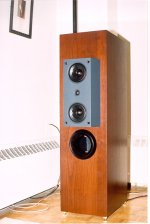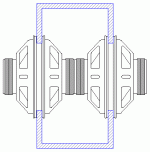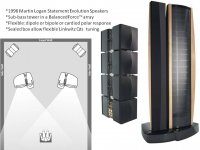Bill F, your epiphany came about 18 years too late!!. At KEF, we coupled the woofers together in the manner you describe, to both cancel the non-linearity and the reaction force. We did add a rolling seal in place of the dustcap we removed, otherwise you can get air chuffing out from the coil at high excursions.
I should add that even cabinets made from 1 inch plywood with extensive cross bracing don't even come close in terms of vibration to the results obtained from force cancellation.
Andrew
I should add that even cabinets made from 1 inch plywood with extensive cross bracing don't even come close in terms of vibration to the results obtained from force cancellation.
Andrew
AndrewJ said:18 years ... At KEF, we coupled the woofers together in the manner you describe
Andrew,
Are you talking about the Reference 104 IIs.
An externally hosted image should be here but it was not working when we last tested it.
dave
Dave, thie 104/2 was prcisely the model I was talking about, and we continued with this concept in many subsequent models. When it came to developing the first THX subwoofer, I initially tried an enclosure without force cancelling, thinking that 1 inch plywood cross-braced by virtue of building as a dual coupled cavity would be strong enough. It wasn't. Adding force cancelling made a dramatic improvement to the box vibration.
In Later models, the force cancelling bar was made more substantial, since at higher frequencies the bar will vibrate in cross modes, like a string, and reduce the effectiveness of the cancellation. This was dealt with in the earlier models such as the 104/2 by floating the woofers on isolation mounts.
Andrew
In Later models, the force cancelling bar was made more substantial, since at higher frequencies the bar will vibrate in cross modes, like a string, and reduce the effectiveness of the cancellation. This was dealt with in the earlier models such as the 104/2 by floating the woofers on isolation mounts.
Andrew
Using a push-pull or isobaric configurations is very costly to get the best results. Also placing two woofers on the opposite sides of the box does cancel the sound. Ever heard speaker drivers in free air. They sounded very thin with minimal bass extension. The use of dipole subwoofers is using multiple high Q drivers to conpensate for the loss although the bass extension never goes lower than 40 Hz. The best way is making two seperate boxes. Then place a woofer in each box. This box can be a cube because the resonant frequency of the box does not reach to subwoofer frequencies. Cube subwoofers makes the enclosure smaller than it really is. If you want a balanced sub use three passive radiator per box. This will give you very low bass extension and very high SPL.
With good bracing the enclosure can be very rigid.
Dipole Information:
http://www.diysubwoofers.org/dipole/
Push-Pull (isobaric):
http://www.jlaudio.com/tutorials/isobarik/index.html
With good bracing the enclosure can be very rigid.
Dipole Information:
http://www.diysubwoofers.org/dipole/
Push-Pull (isobaric):
http://www.jlaudio.com/tutorials/isobarik/index.html
Electro, You have missed the point of our discussion with woofers on opposite sides of the box. They are not operating as dipoles, as this would require one driver to move out of the box while the other was moving in. This would not cancel the reaction forces. The configuration under discussion is where both drivers move outwards simultaneously. This is a monopole (or bi-pole) configuration.
Bracing a box is like closing the stable door after the horse has bolted. If you brace a box, you will strengthen it and move the panel resonant frequency higher (possibly outside of the passband of the subwoofer). However, force cancelling will always provide a well worthwhile additional improvement and whenever using 2 drivers one would be foolish to not take advantage of it's benefits.
Bracing a box is like closing the stable door after the horse has bolted. If you brace a box, you will strengthen it and move the panel resonant frequency higher (possibly outside of the passband of the subwoofer). However, force cancelling will always provide a well worthwhile additional improvement and whenever using 2 drivers one would be foolish to not take advantage of it's benefits.
This little digression reminds me,
In a two/4?-driver alignment, my understanding is that it is beneficial to compartmentalize the drivers/isobaric pairs. Since no two drivers are identical, this limits the interaction of their slightly different parameters to the electrical end of things. It seems to me it would also double the frequency of the first standing wave (while, of course, Fb remains basically unchanged)
Is this correct/worth doing, or are there some beneficial mutual damping effects from sharing one elclosed volume?
Bill
In a two/4?-driver alignment, my understanding is that it is beneficial to compartmentalize the drivers/isobaric pairs. Since no two drivers are identical, this limits the interaction of their slightly different parameters to the electrical end of things. It seems to me it would also double the frequency of the first standing wave (while, of course, Fb remains basically unchanged)
Is this correct/worth doing, or are there some beneficial mutual damping effects from sharing one elclosed volume?
Bill
Bill, you are basically correct, though the interation is minimal if the drivers are wired in parallel. If they are in series, their response is unaffected IF the drivers are identical. However this is rarely the case, especially for the driver compliance. Then at low frequencies, in a reflex enclosure where the driver motion is controlled by the spider compliance, instability can occur. If the enclosures are acoustically separate, then this instability no longer takes place. Also, as you say, the standing wave frequencies are beneficially raised, at least in one dimension.
It is however still possible and beneficial to apply force cancelling in such a divided box.
Andrew
It is however still possible and beneficial to apply force cancelling in such a divided box.
Andrew
I finally came up with a design that could be built without excess complexity, have to draw and get the end plates cut.
I have the 8 12" woofers (gonna build 2 of them), and the 55cm long pieces of 12" diameter PVC that will be the main body of the enclosure.
It is some 10 years since i did that drawing, so you can see i'm in no rush.
dave
I have the 8 12" woofers (gonna build 2 of them), and the 55cm long pieces of 12" diameter PVC that will be the main body of the enclosure.
It is some 10 years since i did that drawing, so you can see i'm in no rush.
dave
MAY THE FORCE BE WITH YOU!
In 1998 Martin Logan launched the $120,000 flagship Statement Evolution_2 speaker which used eight proprietary 12" (30.4cm) paper cone drivers per sub-bass tower in a BalancedForce™ array. Picture 1 shows how eight woofers, each in a separate sealed enclosure, can be mounted in back-to-back counter-force pairs, and then optionally pair-stached into a line array topology that helps smooth out some floor/ceiling room mode effects.
FLEXIBILITY - FLEXIBILITY - FLEXIBILITY
1) sealed woofers can provide superior transient response compared to ported woofers, and a Linkwitz Transform circuit allows tuning the Qts of the speaker to the listener's preference
2) putting each woofer in a separate enclosure assures that air displaced betweem the woofers does not interact to unevenly rock the cone suspension. Top-bottom woofers in one common air volume will produce unequal air force in the center than in the corners which can rock the cones, generating distortion and early failure. Similar cone-rock occurs in ported speakers if the ports are only in the center or only at the bottom of the cabinet.
3) back-to-back woofer pairs can be wired to perform as: bipoles, or dipoles, or cardiods with some added delay. This provides great flexibility for optimizing the listener's preferences for bass polar response, as well as flexible room placement and controlling room modes.
4) sealed woofers have lower efficiency that ported woofers, so high power amplifiers are required. Using multiple woofers helps provide very dynamic bass
5) each woofer or woofer-pair can be placed around a room to smooth out room modes
MartinLogan | Statement E2
In 1998 Martin Logan launched the $120,000 flagship Statement Evolution_2 speaker which used eight proprietary 12" (30.4cm) paper cone drivers per sub-bass tower in a BalancedForce™ array. Picture 1 shows how eight woofers, each in a separate sealed enclosure, can be mounted in back-to-back counter-force pairs, and then optionally pair-stached into a line array topology that helps smooth out some floor/ceiling room mode effects.
FLEXIBILITY - FLEXIBILITY - FLEXIBILITY
1) sealed woofers can provide superior transient response compared to ported woofers, and a Linkwitz Transform circuit allows tuning the Qts of the speaker to the listener's preference
2) putting each woofer in a separate enclosure assures that air displaced betweem the woofers does not interact to unevenly rock the cone suspension. Top-bottom woofers in one common air volume will produce unequal air force in the center than in the corners which can rock the cones, generating distortion and early failure. Similar cone-rock occurs in ported speakers if the ports are only in the center or only at the bottom of the cabinet.
3) back-to-back woofer pairs can be wired to perform as: bipoles, or dipoles, or cardiods with some added delay. This provides great flexibility for optimizing the listener's preferences for bass polar response, as well as flexible room placement and controlling room modes.
4) sealed woofers have lower efficiency that ported woofers, so high power amplifiers are required. Using multiple woofers helps provide very dynamic bass
5) each woofer or woofer-pair can be placed around a room to smooth out room modes
MartinLogan | Statement E2
Attachments
- Status
- This old topic is closed. If you want to reopen this topic, contact a moderator using the "Report Post" button.
- Home
- Loudspeakers
- Multi-Way
- when designing a 2 woofer enclosure...


